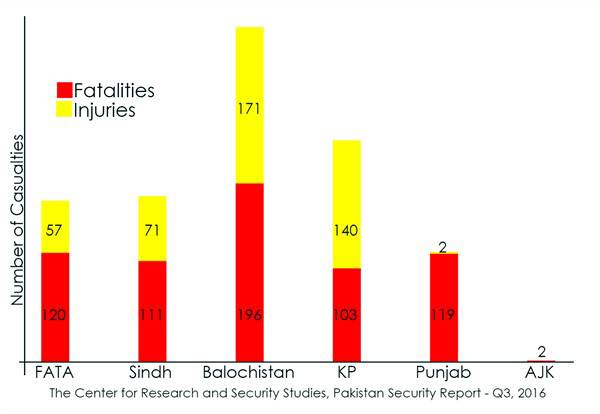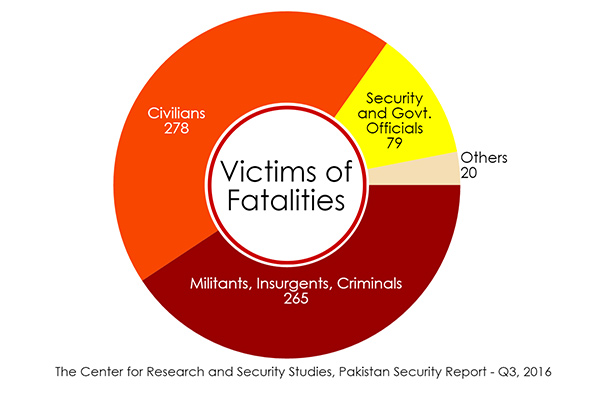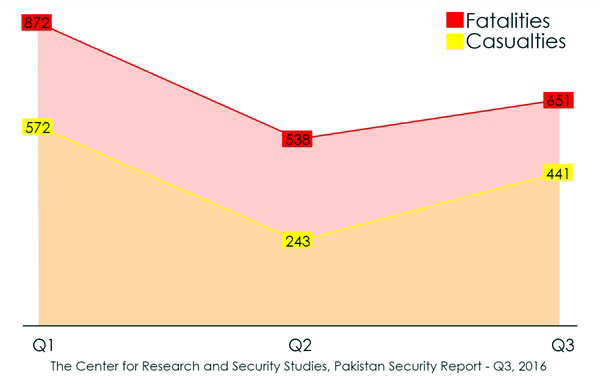
The brazen attack in Quetta this Monday night is indicative of several troublesome trends. First, it reveals serious security lapses and failures at the highest levels. Second, it reinforces the idea that despite a concerted initial push in a state of national grief after the Army Public School attack on December 16, 2014—that claimed the lives of 144, mostly children—the political will dried up, the focus shifted to the next big catastrophe, and the government re-prioritized. This second point can be best exemplified by the fact that the first meeting by the prime minister to gauge progress on the National Action Plan (NAP) was called 19 months into its enactment. Third, and perhaps most problematically, it defies the state’s narrative that terrorism has been mostly curbed, and legitimizes the extremist element as a potent, resourceful foe.

Data from the Center for Research and Security Studies ‘Pakistan Security Report, Q3, 2016’ reveals that this quarter saw a rise in violence-related casualties across Pakistan, with 651 fatalities, and 441 injuries. This is still lower than the 872 fatalities and 572 injuries reported in the first quarter of the year.
The interior ministry’s claim that the number of attacks has been reduced significantly is not without merit. A comparative study reveals that there was an overall 40% reduction in violence-related casualties in 2015 over 2014. However, a deeper look also shows that the bulk of this came from a remarkable reduction in violence in Karachi, which alone accounted for well over a quarter of the country’s violence-related fatalities. Data from the first three quarters shows that violence-related fatalities have continued to decline rapidly across the country, with the exception of Balochistan.
Within victims, the broad groups with the most fatalities were militants, insurgents and criminals (256), civilians (278), and security and government officials (79). It must also be said that overall percentage of civilians and security/government officials has risen, while that of militants has dropped this quarter.
Now that the situation in Karachi has hit a plateau, and crime or violence there is at its lowest in years, the country’s violence data should also begin to stabilize. However, high-profile attacks result in major spikes on a month-to-month, quarter-to-quarter basis. Apart from Karachi, a major source of violence-related fatalities was Operation Zarb-e-Azb, originally launched on June 15, 2014 after the attack on Karachi airport. This was concluded earlier in the year, but the militancy in the Federally Administered Tribal Areas did not subside. In the third quarter of 2016, the Pakistan Air Force conducted air raids, killing 51 militants, which calls into question the claim that the area is void of militant presence. North Waziristan, however, once considered a no-go area for law enforcement of any kind, remained peaceful this quarter, with zero fatalities reported.

With Karachi and FATA stabilizing, Balochistan has not only pulled ahead in the level of violence, but the number of fatalities reported has also increased. This week’s attack will only contribute to this trend. The third quarter was the most violent quarter this year for the province, with 196 fatalities reported.
Violence-related activities against sectarian groups rose drastically during this quarter from only 16 fatalities in the second quarter to 52 in the third one. Fatalities from sectarian violence were reported in FATA (36), KP (6), Sindh (6) and Balochistan (4) during this period. Punjab and Islamabad were the only areas not affected by sectarian violence. Of the 52 fatalities, 40 were recorded in September, five in July and seven in August during this quarter.
This data suggests that the fight is far from over, and the unconditional implementation of rule of law should be the most paramount objective moving forward.
Aliases: LeJ, Army of Jhangvi, Lashkar-i-Jhangvi, Lashkar-e-Jhangvi al-Alami
History: Lashkar-e-Jhangvi (LeJ) is a Sunni extremist group founded in 1996 in Pakistan. The group seeks to transform Pakistan into a Sunni state by violent means, targeting the nation’s Ahle Tasheeh or Shia minority. The LeJ originally formed as a splinter of the Sipah-e-Sahaba Pakistan (SSP), a similar sectarian extremist organization, after members began to feel the SSP had strayed too far from the ideals of its late co-founder, Maulana Haq Nawaz Jhangvi. These founding members and leaders include Riaz Basra, Malik Ishaq, and Akram Lahori.
Allies and suspected allies:
Sipah-e-Sahaba Pakistan (SSP) (founding group)
Jaish-e-Mohammed (JeM) (ally)
Taliban (ally)
Haqqani Network (ally)
Tehrik-i-Taliban Pakistan (TTP) (ally)
Al-Qa’ida (ally)
SOURCE: National Consortium for the Study of Terrorism and Responses to Terrorism, University of Maryland with the Department of Homeland Security
The author serves as a senior research fellow at the Center for Research and Security Studies, Islamabad and is a freelance journalist. He tweets @zeesalahuddin

Data from the Center for Research and Security Studies ‘Pakistan Security Report, Q3, 2016’ reveals that this quarter saw a rise in violence-related casualties across Pakistan, with 651 fatalities, and 441 injuries. This is still lower than the 872 fatalities and 572 injuries reported in the first quarter of the year.
The interior ministry’s claim that the number of attacks has been reduced significantly is not without merit. A comparative study reveals that there was an overall 40% reduction in violence-related casualties in 2015 over 2014. However, a deeper look also shows that the bulk of this came from a remarkable reduction in violence in Karachi, which alone accounted for well over a quarter of the country’s violence-related fatalities. Data from the first three quarters shows that violence-related fatalities have continued to decline rapidly across the country, with the exception of Balochistan.
Within victims, the broad groups with the most fatalities were militants, insurgents and criminals (256), civilians (278), and security and government officials (79). It must also be said that overall percentage of civilians and security/government officials has risen, while that of militants has dropped this quarter.
Now that the situation in Karachi has hit a plateau, and crime or violence there is at its lowest in years, the country’s violence data should also begin to stabilize. However, high-profile attacks result in major spikes on a month-to-month, quarter-to-quarter basis. Apart from Karachi, a major source of violence-related fatalities was Operation Zarb-e-Azb, originally launched on June 15, 2014 after the attack on Karachi airport. This was concluded earlier in the year, but the militancy in the Federally Administered Tribal Areas did not subside. In the third quarter of 2016, the Pakistan Air Force conducted air raids, killing 51 militants, which calls into question the claim that the area is void of militant presence. North Waziristan, however, once considered a no-go area for law enforcement of any kind, remained peaceful this quarter, with zero fatalities reported.

With Karachi and FATA stabilizing, Balochistan has not only pulled ahead in the level of violence, but the number of fatalities reported has also increased. This week’s attack will only contribute to this trend. The third quarter was the most violent quarter this year for the province, with 196 fatalities reported.
Violence-related activities against sectarian groups rose drastically during this quarter from only 16 fatalities in the second quarter to 52 in the third one. Fatalities from sectarian violence were reported in FATA (36), KP (6), Sindh (6) and Balochistan (4) during this period. Punjab and Islamabad were the only areas not affected by sectarian violence. Of the 52 fatalities, 40 were recorded in September, five in July and seven in August during this quarter.
This data suggests that the fight is far from over, and the unconditional implementation of rule of law should be the most paramount objective moving forward.
Lashkar-e-Jhangvi at a glance
Aliases: LeJ, Army of Jhangvi, Lashkar-i-Jhangvi, Lashkar-e-Jhangvi al-Alami
History: Lashkar-e-Jhangvi (LeJ) is a Sunni extremist group founded in 1996 in Pakistan. The group seeks to transform Pakistan into a Sunni state by violent means, targeting the nation’s Ahle Tasheeh or Shia minority. The LeJ originally formed as a splinter of the Sipah-e-Sahaba Pakistan (SSP), a similar sectarian extremist organization, after members began to feel the SSP had strayed too far from the ideals of its late co-founder, Maulana Haq Nawaz Jhangvi. These founding members and leaders include Riaz Basra, Malik Ishaq, and Akram Lahori.
Allies and suspected allies:
Sipah-e-Sahaba Pakistan (SSP) (founding group)
Jaish-e-Mohammed (JeM) (ally)
Taliban (ally)
Haqqani Network (ally)
Tehrik-i-Taliban Pakistan (TTP) (ally)
Al-Qa’ida (ally)
SOURCE: National Consortium for the Study of Terrorism and Responses to Terrorism, University of Maryland with the Department of Homeland Security
The author serves as a senior research fellow at the Center for Research and Security Studies, Islamabad and is a freelance journalist. He tweets @zeesalahuddin

